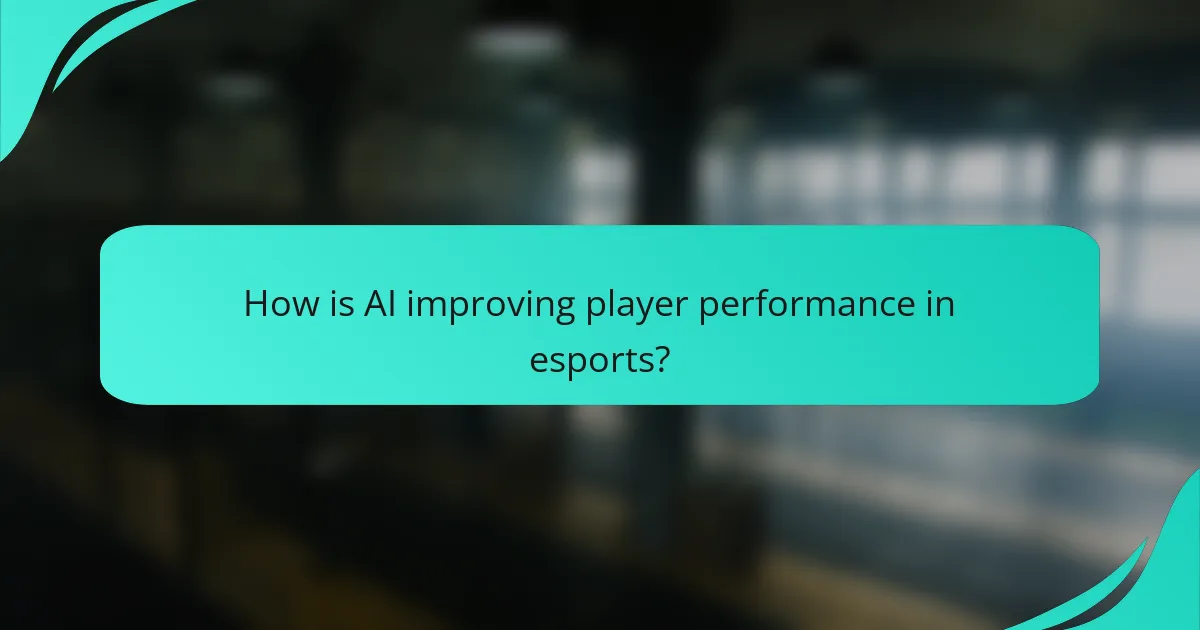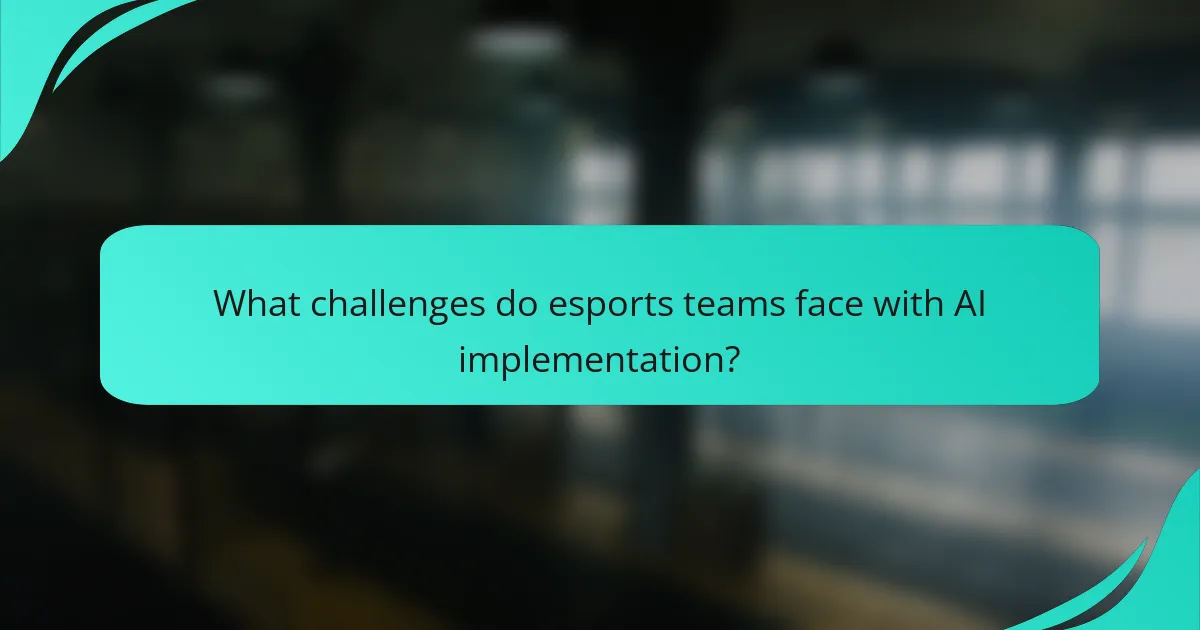Artificial Intelligence is revolutionizing the esports landscape by significantly enhancing player performance through advanced analytics and personalized training. By leveraging real-time feedback and data-driven insights, AI tools enable players to identify their strengths and weaknesses, optimize strategies, and ultimately improve their gameplay efficiency. These technologies not only evaluate performance metrics but also analyze player behavior, facilitating better decision-making for both individuals and teams.

How is AI improving player performance in esports?
AI enhances player performance in esports by providing advanced analytics, personalized training, and real-time feedback. These technologies allow players to identify strengths and weaknesses, optimize their strategies, and improve overall gameplay efficiency.
Enhanced training simulations
AI-driven training simulations create realistic gaming environments that mimic actual competition scenarios. These simulations help players practice under various conditions, allowing them to refine their skills and adapt to different strategies.
For example, AI can generate opponents with varying skill levels, enabling players to challenge themselves progressively. This tailored approach ensures that training remains engaging and effective, promoting continuous improvement.
Real-time performance feedback
Real-time performance feedback from AI tools allows players to receive immediate insights during gameplay. This instant analysis helps players make quick adjustments, enhancing their decision-making and overall performance.
Tools like AI-assisted overlays can highlight critical moments, such as missed opportunities or suboptimal moves, enabling players to learn and adapt on the fly. This immediate feedback loop is crucial for developing skills in fast-paced esports environments.
Personalized coaching strategies
AI can analyze a player’s unique gameplay style and suggest personalized coaching strategies tailored to their strengths and weaknesses. This customization leads to more effective training sessions and better overall performance.
For instance, an AI system might recommend specific drills or focus areas based on a player’s past performances, ensuring that coaching is relevant and targeted. This approach maximizes the efficiency of training time and resources.
Data-driven decision making
Data-driven decision making in esports leverages AI to analyze vast amounts of gameplay data, providing insights that inform strategic choices. Players and teams can use these insights to develop tactics that exploit opponents’ weaknesses.
For example, AI can identify patterns in an opponent’s gameplay, allowing teams to prepare counter-strategies. This analytical approach helps players make informed decisions rather than relying solely on intuition, leading to improved competitive outcomes.

What AI tools are used for player analysis in esports?
AI tools for player analysis in esports enhance performance evaluation by providing data-driven insights. These tools analyze gameplay metrics, player behavior, and strategies to help teams and individual players improve their skills and decision-making.
IBM Watson for esports analytics
IBM Watson leverages artificial intelligence to analyze vast amounts of gameplay data, offering insights into player performance and team dynamics. It utilizes machine learning algorithms to identify patterns and trends, which can inform coaching strategies and in-game decisions.
Teams can use Watson to generate reports that highlight strengths and weaknesses, allowing for targeted training sessions. For example, it can analyze player movements and decision-making processes, helping coaches create tailored improvement plans.
Gamer Sensei for coaching
Gamer Sensei connects players with professional coaches who utilize AI tools to enhance training effectiveness. Coaches analyze gameplay footage and performance metrics to provide personalized feedback and strategies for improvement.
This platform allows players to receive real-time insights and structured lessons based on their unique gameplay styles. By focusing on specific areas for growth, players can maximize their training efficiency and accelerate their skill development.
Mobalytics for performance tracking
Mobalytics offers a comprehensive performance tracking system that evaluates player statistics across various games. It provides detailed analytics on gameplay, including win rates, champion performance, and skill progression, enabling players to understand their strengths and areas for improvement.
With Mobalytics, players can set specific goals and track their progress over time. The platform’s insights help players make informed decisions about their training focus, ensuring they work on the most impactful aspects of their gameplay.

How does AI analyze gameplay data?
AI analyzes gameplay data by employing various algorithms and techniques to extract meaningful insights about player performance and strategies. This process involves collecting data from gameplay sessions, identifying patterns, and generating predictive models to enhance future performance.
Pattern recognition algorithms
Pattern recognition algorithms are essential for identifying trends and behaviors in gameplay data. These algorithms can analyze player movements, decision-making processes, and interaction patterns within the game environment. For example, they can detect common strategies used by players or recognize specific actions that lead to success or failure.
Common techniques include clustering, where similar gameplay styles are grouped together, and classification, which categorizes actions based on their outcomes. By leveraging these methods, teams can tailor their training and strategies to improve overall performance.
Statistical modeling techniques
Statistical modeling techniques provide a framework for understanding the relationships between different gameplay variables. These models can quantify the impact of specific actions on game outcomes, helping teams make data-driven decisions. For instance, regression analysis can reveal how factors like player positioning or resource management influence victory rates.
Using statistical models, teams can simulate various scenarios to predict outcomes based on historical data. This approach allows for better preparation and strategy development, ensuring that players are equipped to handle different in-game situations effectively.
Machine learning for predictive analysis
Machine learning enhances predictive analysis by allowing systems to learn from past gameplay data and improve over time. Algorithms can be trained to forecast player performance, identify potential weaknesses, and suggest optimal strategies based on real-time data. For example, a machine learning model might predict the likelihood of a player winning based on their previous matches and current in-game conditions.
Implementing machine learning requires careful consideration of data quality and algorithm selection. Teams should ensure they have access to comprehensive datasets and choose models that best fit their specific needs. Regularly updating these models with new data is crucial for maintaining accuracy and relevance in predictions.

What are the benefits of AI insights for esports teams?
AI insights provide esports teams with data-driven analysis that enhances performance, strategy, and decision-making. By leveraging AI, teams can gain a deeper understanding of player behaviors, opponent strategies, and overall game dynamics, leading to improved outcomes.
Improved strategic planning
AI can analyze vast amounts of game data to identify patterns and trends that inform strategic planning. Teams can use these insights to develop tailored game strategies that exploit opponents’ weaknesses while maximizing their strengths. For example, AI might reveal that a particular team struggles against aggressive playstyles, prompting a more offensive approach in upcoming matches.
Additionally, AI tools can simulate various scenarios, allowing teams to prepare for different in-game situations. This proactive approach helps teams adapt quickly during matches, increasing their chances of success.
Enhanced player recruitment
AI insights can significantly improve the player recruitment process by evaluating potential candidates based on performance metrics and gameplay styles. Teams can analyze data from various tournaments to identify players who consistently perform well under pressure or excel in specific roles. This data-driven approach reduces the reliance on subjective assessments and increases the likelihood of finding talent that fits the team’s needs.
Moreover, AI can assess player compatibility with existing team dynamics, ensuring that new recruits can integrate smoothly. This can lead to a more cohesive team environment and better overall performance.
Increased competitive advantage
By utilizing AI insights, esports teams can gain a substantial competitive edge over their rivals. The ability to analyze opponent strategies and predict their moves allows teams to stay one step ahead. For instance, AI can track an opponent’s past matches to identify their preferred tactics, enabling teams to counteract effectively.
Furthermore, continuous monitoring of player performance through AI can help in identifying areas for improvement. Teams can implement targeted training regimens based on these insights, leading to enhanced skills and overall team performance. This focus on data-driven improvement can be the difference between winning and losing in high-stakes competitions.

What challenges do esports teams face with AI implementation?
Esports teams encounter several challenges when implementing AI, including data privacy concerns, integration with existing systems, and the cost of technology adoption. Addressing these issues is crucial for leveraging AI effectively to enhance player performance and analysis.
Data privacy concerns
Data privacy is a significant challenge for esports teams using AI, as they often handle sensitive player information. Teams must comply with regulations like the General Data Protection Regulation (GDPR) in Europe, which mandates strict data handling practices.
Ensuring that player data is anonymized and securely stored can mitigate risks. Teams should implement robust data protection measures and regularly audit their practices to maintain compliance and build trust with players.
Integration with existing systems
Integrating AI solutions with existing systems can be complex and time-consuming. Teams often use various software for training, analysis, and communication, making seamless integration essential for maximizing AI benefits.
To facilitate integration, teams should evaluate AI tools that offer compatibility with their current systems. Conducting thorough testing and involving IT specialists during implementation can help prevent disruptions in workflow.
Cost of technology adoption
The cost of adopting AI technology can be a barrier for many esports teams, especially smaller organizations. Initial investments in software, hardware, and training can be substantial, potentially reaching thousands of dollars.
Teams should consider phased adoption, starting with essential AI tools that provide immediate benefits. Exploring partnerships or sponsorships can also help offset costs while allowing teams to leverage advanced analytics and performance insights.

How can teams choose the right AI tools for their needs?
Teams can choose the right AI tools by clearly defining their specific requirements and evaluating the effectiveness of available options. This process involves understanding the team’s goals, the types of data they will analyze, and the features that will best support their performance analysis.
Assessing team requirements
Start by identifying the team’s objectives, such as improving player performance, strategizing game plans, or analyzing opponent tactics. Consider the types of data available, including gameplay statistics, player behavior, and historical performance metrics. This will help narrow down the tools that align with the team’s goals.
Next, evaluate the technical capabilities of the team. Teams with data science expertise may benefit from more complex AI solutions, while those with limited resources might prefer user-friendly tools that require minimal technical knowledge. Establishing these requirements will guide the selection process.
Evaluating tool effectiveness
Once potential AI tools are identified, assess their effectiveness through trials or demos. Look for tools that provide actionable insights, ease of integration with existing systems, and user support. Gathering feedback from team members who will use the tools can also highlight usability and functionality.
Consider comparing tools based on key performance indicators such as accuracy of predictions, speed of analysis, and overall impact on team performance. A simple checklist can help in this evaluation: does the tool meet the defined requirements, is it scalable, and does it offer ongoing updates or improvements?
